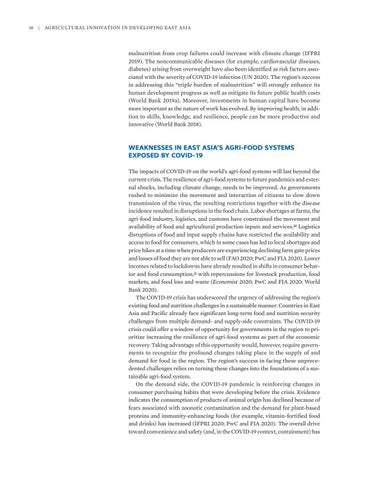16 | Agricultural Innovation in Developing East Asia
malnutrition from crop failures could increase with climate change (IFPRI 2019). The noncommunicable diseases (for example, cardiovascular diseases, diabetes) arising from overweight have also been identified as risk factors associated with the severity of COVID-19 infection (UN 2020). The region’s success in addressing this “triple burden of malnutrition” will strongly enhance its human development progress as well as mitigate its future public health costs (World Bank 2019a). Moreover, investments in human capital have become more important as the nature of work has evolved. By improving health, in addition to skills, knowledge, and resilience, people can be more productive and innovative (World Bank 2018).
WEAKNESSES IN EAST ASIA’S AGRI-FOOD SYSTEMS EXPOSED BY COVID-19 The impacts of COVID-19 on the world’s agri-food systems will last beyond the current crisis. The resilience of agri-food systems to future pandemics and external shocks, including climate change, needs to be improved. As governments rushed to minimize the movement and interaction of citizens to slow down transmission of the virus, the resulting restrictions together with the disease incidence resulted in disruptions in the food chain. Labor shortages at farms, the agri-food industry, logistics, and customs have constrained the movement and availability of food and agricultural production inputs and services.10 Logistics disruptions of food and input supply chains have restricted the availability and access to food for consumers, which in some cases has led to local shortages and price hikes at a time when producers are experiencing declining farm gate prices and losses of food they are not able to sell (FAO 2020; PwC and FIA 2020). Lower incomes related to lockdowns have already resulted in shifts in consumer behavior and food consumption,11 with repercussions for livestock production, food markets, and food loss and waste (Economist 2020; PwC and FIA 2020; World Bank 2020). The COVID-19 crisis has underscored the urgency of addressing the region’s existing food and nutrition challenges in a sustainable manner. Countries in East Asia and Pacific already face significant long-term food and nutrition security challenges from multiple demand- and supply-side constraints. The COVID-19 crisis could offer a window of opportunity for governments in the region to prioritize increasing the resilience of agri-food systems as part of the economic recovery. Taking advantage of this opportunity would, however, require governments to recognize the profound changes taking place in the supply of and demand for food in the region. The region’s success in facing these unprecedented challenges relies on turning these changes into the foundations of a sustainable agri-food system. On the demand side, the COVID-19 pandemic is reinforcing changes in consumer purchasing habits that were developing before the crisis. Evidence indicates the consumption of products of animal origin has declined because of fears associated with zoonotic contamination and the demand for plant-based proteins and immunity-enhancing foods (for example, vitamin-fortified food and drinks) has increased (IFPRI 2020; PwC and FIA 2020). The overall drive toward convenience and safety (and, in the COVID-19 context, containment) has

